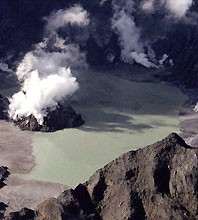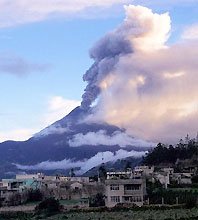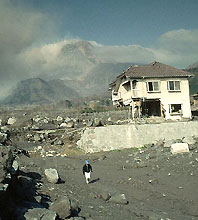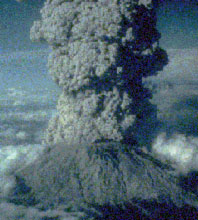|
Can we forecast volcanic eruptions?
The answer to the question above depends to a certain degree on whom you ask. Dan Miller of the Cascades
Volcano Observatory, for one, is bearish. "I don't think eruptions can be
consistently predicted," he told me. By contrast, volcanologist Bill Rose of
Michigan Technological University is bullish. "If we have enough money," he
said, "we can predict eruptions."
Why such widely divergent opinions? Can we or can't we?
The answer, perhaps not surprisingly, is complicated. In fact, Miller and Rose
are not as far apart on this issue as they might sound. John Eichelberger, a
volcanologist at the University of Alaska Fairbanks, may have summed up the
situation best when I asked him if the field was well on its way to becoming an
exact science or was still in its infancy. He chuckled and said, "Well, when it
works, it's well on its way. When we have a spectacular failure, it's in its
infancy."
 When it works, when it fails
When it works, when it fails

Both scenarios have occurred in recent years. Mt. Pinatubo in the Philippines
is one of eruption forecasting's great success stories. When it awoke in the
spring of 1991, volcanologists rushed in, installed monitoring equipment, and
correctly identified the nature of the unrest. They rapidly completed a hazard
assessment, based in part on looking at evidence from past eruptions there. And
they provided good advice to public officials and the Philippine and U.S.
militaries. Just days before the mountain exploded on June 15, the Filipino
government successfully evacuated more than 60,000 people from towns and
villages (and the U.S. Clark Air Base) that were later partly or wholly
destroyed.
Tungurahua volcano in Ecuador, on the other hand, might fall in the
"spectacular failure" category of eruption forecasting. (Like meteorologists,
most volcanologists tellingly prefer the less precise term "forecasting" to
"predicting.") When Tungurahua woke up in 1999, volcanologists from the USGS's
Volcano Disaster Assistance Program (VDAP) quickly helped their Ecuadoran
colleagues set up monitoring equipment to evaluate the hazards and track the
volcano's restlessness. When a magmatic eruption began there, the team smelled
trouble: Three well-documented eruptions within the past 300 years that had
begun just that way had resulted in explosive eruptions that devastated the
volcano's flanks and killed large numbers of people. Based on the 1999 team's
urgent recommendation, the Ecuadoran authorities evacuated more than 15,000
people living beneath the volcano.
Five years later, Tungurahua, while gurgling on a daily basis, has yet to
produce any major explosive eruptions. "It was an economic and political
disaster, and a worse one is in the making, because those 15,000 people
returned to their villages and have categorically refused to leave again," says
Miller, who directs VDAP and led the 1999 team. Miller fears the mountain could
still produce damaging eruptions.
Why the disparity in results between Pinatubo and Tungurahua? The reason is
that when a volcano shows signs of disquiet, even one that is thoroughly known
and instrumented, volcanologists can still never be certain when it will erupt,
in what way, and to what degree—or even if it will erupt at all.
 Reason for hope
Reason for hope

While that may not sound reassuring, the volcanological community has actually
made great strides in eruption forecasting in recent years. Arguably the most
significant strides have come in the development of new tools for detecting
changes in a volcano's seismicity, ground deformation, and gases—the Big
Three to watch at an active volcano.
Seismic networks have improved enormously. Broadband seismic sensors coupled
with improved telemetry and computer systems now enable volcanologists, like
never before, to receive, analyze, and display information about the
earthquakes that typically precede eruptions. When it comes to gauging the
slight swellings of ground surface that can signal an impending eruption,
volcanologists today use satellite-based Synthetic Aperture Radar systems that
can detect even the minutest elevation changes over an entire volcano, as well
as ground-based GPS units that can communicate deformation data to volcano
observatories in near real time.

So can we forecast eruptions? The best answer, for now, seems to be
“sometimes.”

As for monitoring gases, volcanologists two decades ago mostly measured
releases of sulfur dioxide, which can give an indication of whether
potentially explosive magma is approaching the surface. But now they can
monitor a suite of gases, primarily sulfur dioxide, carbon dioxide, and hydrogen sulfide.
Flying through a plume of gas rising from a volcano, volcanologists can very
accurately calculate the flux of these three gases in terms of tons per day.
Researchers are even starting to reach within volcanoes themselves in hopes of
getting a better idea of their plumbing. Eichelberger is part of an
international team that in July 2004 managed to drill into the main magma
conduit that feeds Unzen, a dangerously active volcano in Japan. (An eruption
there in 1792 killed more than 15,000 people—see Deadly Volcanoes.) The
conduit's now-solidified contents, samples of which the team has collected,
hold valuable clues to the magma's composition, temperature, and pressure
as it rose to the surface during Unzen's last eruption, which lasted for four years in the
early 1990s.
 Hurdles
Hurdles

Despite these advances, many obstacles remain to successful forecasting. For
starters, it takes a long time to gain a good understanding of even a single
volcano's behavior. The more former eruptions to study the better, but if a
volcano only erupts on average every several hundred years, that understanding
can be elusive.
For some major eruptions, volcanologists have had virtually nothing to work
from. The 1912 explosion of Novarupta volcano in Alaska was the most dramatic
volcanic event of the 20th century, packing 10 times the force of Mt. St.
Helens's May 18, 1980 eruption. But the magnitude of the cataclysm came as a
complete surprise. "I doubt even today if we would guess the scale of it,
because nothing like that had happened there for millions of years," says
Eichelberger, who doubles as Coordinating Scientist for the Alaska Volcano
Observatory. "You don't guess complete changes in behavior like that."
Moreover, every volcano has a unique plumbing system, and each has its own
supply rate of magma from sources deep underground. That means generalizing
from one to the next can be tricky. "In other words, what we've learned about
Mt. St. Helens does not tell us much about Mt. Shasta or Mt. Hood," says
Miller, who is based in the Cascade Mountains of the Pacific Northwest. Even
for the best known and best instrumented volcanoes in the world, volcanologists
can never be certain how they will behave when they come alive. Despite
numerous well-studied eruptions at Mt. St. Helens since the 1980 catastrophe,
for instance, experts were unable to say during its awakening in 2004 whether
its eruptions would be effusive or explosive—that is, a burp or a
blast.
Other obstacles to forecasting are financial. "The problem is, there are 900
potentially active volcanoes in the world, and only about a tenth of them are
instrumented enough to provide forecast capability," Bill Rose says. "We have
the technology to do it, but the cost is too high to instrument the whole
world." Many threatening volcanoes in Central and South America, Africa, and
the southwest Pacific have little or no scientific scrutiny. Cerro Quemado in
Guatemala, for example, has tens of thousands of people living around it, yet
Miller says he's not aware of any monitoring on that peak, not even a single
seismometer. Even the USGS has limited funding for researchers eager to plumb
scientific questions about possibly dangerous volcanoes in the U.S. "Basically
we're doing the best that we can with the budget we have, using the tools that
give us the biggest bang for the buck," Miller says.
So can we forecast eruptions? The best answer, for now, seems to be
"sometimes."


| 

Blowing hot and cold: active volcanoes like Mt.
Pinatubo, whose simmering crater is shown here just over a year after the major
eruption of June 15, 1991, keep experts ever on their toes for possible
unrest.

| |

Ecuador's Tungurahua stands ominously close to
settlements like Pelileo, pictured here in early 2000. When the mountain came
alive in 1999-2000, officials evacuated the nearby town of Banos for three
months.

| |

Mudflows from Unzen volcano took out most of the ground floor of
this house in Shimabara, Japan. In this photo from March 1992, Unzen continues
to erupt in the background.

| |

After its monster cataclysm of May 18, 1980, Mt.
St. Helens continued to erupt periodically for several months. Here, an
eruption plume from July 22 of that year dwarfs both St. Helens and Mt. Rainier
in the distance.

| |
|

